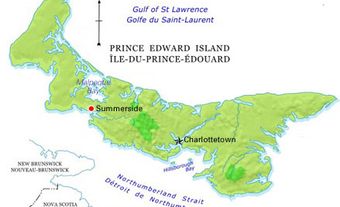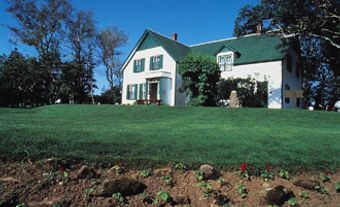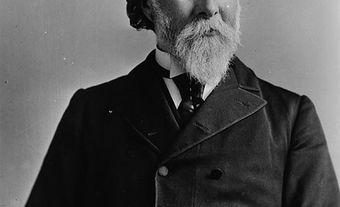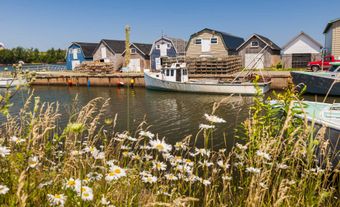Georgetown, Prince Edward Island, incorporated as a town in 1912, population 351 (2021 census), 372 (2016 census). Georgetown is a community within the municipality of Three Rivers. Three Rivers formed in 2018 when Georgetown amalgamated with the town of Montague, the rural municipalities of Brudenell, Cardigan, Lorne Valley, Lower Montague, Valleyfield and 18 other rural areas. Georgetown is the capital of Kings County and is located at the eastern end of PEI on an 8 km-long peninsula.
Indigenous Peoples
Like the province as a whole, Georgetown traces its history of human settlement to the Mi’kmaq, who called the harbour at Georgetown Samook, which means “sandy shore.”
Settlement
During the French period of settlement on Prince Edward Island (then known as Île St-Jean), the population settled just west of present-day Georgetown on a site known as Trois-Rivières. On 17 July 1731, King Louis XV of France authorized a grant to Claude Cottard, Joseph du Boccage, Joseph-Philippe Narcis and Jean-Pierre Roma, who formed the Compagnie de l’Est de l’île Saint-Jean. Their concession was 3,500 arpents long and 40 arpents deep (204.6 km by 2.3 km) on the eastern coast of Île Saint-Jean. It included the lands drained by the Brudenell, Montague and Cardigan rivers.
In the spring of 1732, Roma sailed for New France, arrived at Louisbourg on 6 June, and, after swearing allegiance to King George II (a requirement following the succession of Acadia to England), sailed to what is now Georgetown Harbour. By August of 1734, Roma had cleared land at Trois-Rivières, dug wells, built two piers, five houses, a storehouse, bakery, forge, stable and an icehouse. During the next 10 years, however, the settlement was plagued by tumultuous relations with the local clergy as well as with Roma’s partners in France, a plague of mice that ruined crops and difficulty attracting new settlers. Roma’s settlement on Île Saint-Jean ended on 20 June 1745 when New England troops sent by William Pepperrell after his victorious expedition at Louisbourg destroyed his establishment.
Development
King George III appointed Samuel Holland as surveyor general for Prince Edward Island (now known as Saint John’s Island). During Holland’s 1764 survey he chose the site of present-day Georgetown and named it after the king. The town was laid out on paper in 1768 by surveyor Charles Morris, who had also designed the layout of Halifax, Nova Scotia. Georgetown was slow to develop during the late 18th and early 19th centuries. An election report in the Weekly Recorder newspaper dated 31 August 1811 gives the number of houses in the town as nil.
It wasn’t until the 1830s that Georgetown began to grow with the arrival of immigrants from England, Scotland and Ireland (see Immigration to Canada; English Canadians; Scottish Canadians; Irish Canadians). In an 1833 census, Georgetown was listed as having 59 inhabitants. A public meeting was held to set up a committee to obtain funding for the building of a schoolhouse in February of 1836, and a notice appeared in the Royal Gazette in the spring of 1837 asking for tenders to build a chapel.
Did you know?
The following organizations existed in Georgetown in the 19th century:
- Georgetown Total Abstinence Society (1839)
- Georgetown Agricultural Society (1849)
- Georgetown Temperance Alliance (1861)
- Georgetown Mechanics Institute (1860s)
- Juvenile Lodge – associated with the Order of British Templars (1875)
- James Total Abstinence Society (1877)
- David’s Literacy and Musical Society (1880s)
- The Georgetown Lodge of the Independent Order of Good Templars (1894)
- Christian Endeavour Society (1895)
- Order of the Star of Bethlehem Masonic Lodge (1895)
- Boating Cub (1898)
- Three Rivers Boating Club (1900)
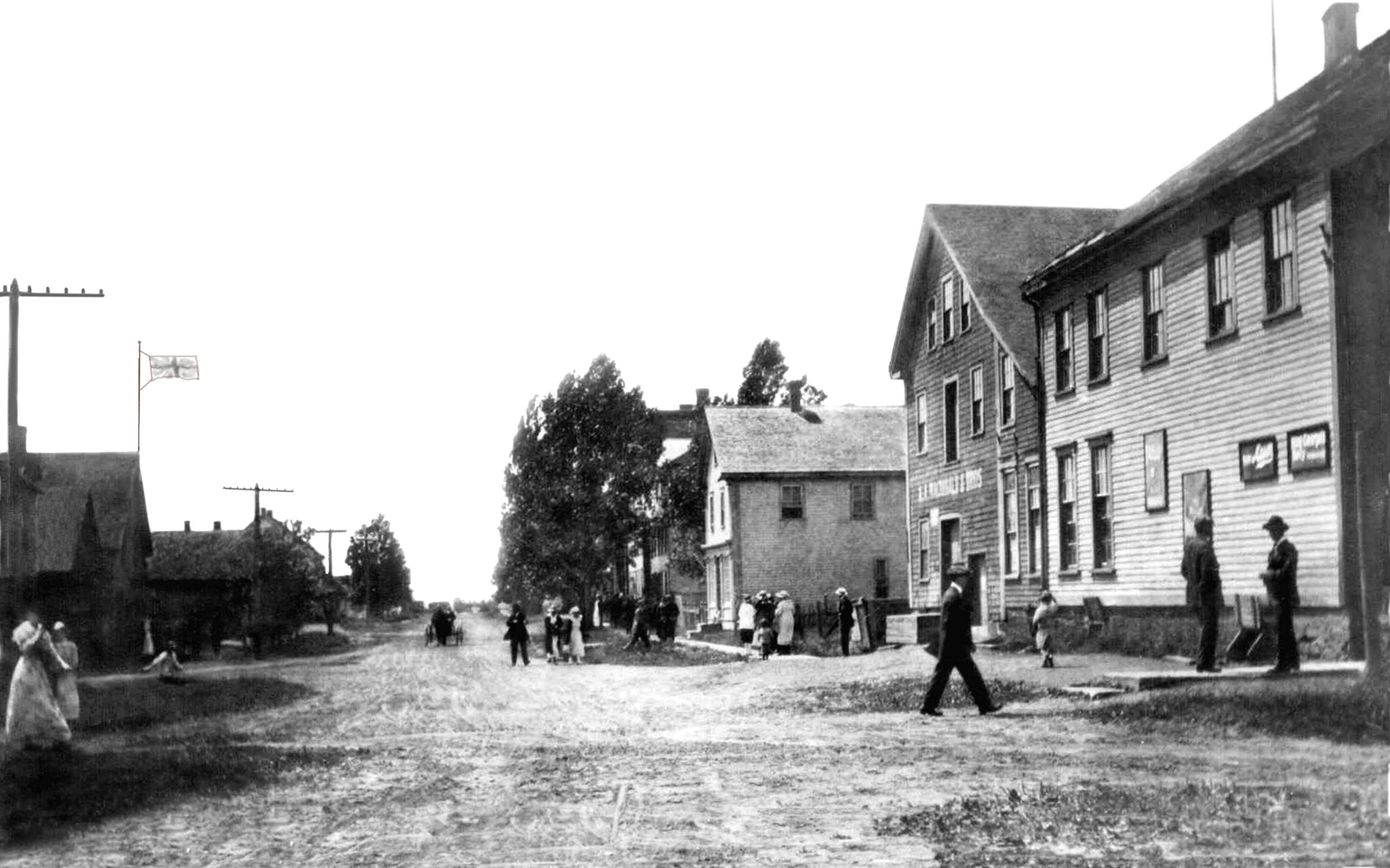
Economy and Labour Force
Having one of the deepest harbours in North America and granted the designation as a free port by the British government in 1839, Georgetown became a transportation hub from the mid-to-late 18th century (see Ports and Harbours). Deep enough to accommodate large ships and ice-free most winter months, throughout the 1840s and 1850s the Georgetown harbour was second only to Charlottetown as the island’s busiest port.
Designed by Charlottetown architect Isaac Smith, who had also designed Province House in Charlottetown, the market building was constructed by 1844 on Kent Street in Georgetown.
Georgetown also benefited from the 1854 Reciprocity Treaty that granted Americans fishing rights on the Island. American fishermen often docked their vessels in the port, which brought business to local merchants. The Hutchinson PEI Directory of 1864 lists for Georgetown: 14 general stores; 9 tavern keepers; 7 hotels; 6 shipbuilders; 5 show makers and tailors; 4 carpenters, druggists and milliners; 3 blacksmiths and saddle and harness makers; 2 auctioneers, carriage makers and grocers; 1 baker, block and pump maker, boarding house, brewer, cabinet maker, cooper, merchant, physician, surveyor, tanner, tinsmith, watchmaker and wheelwright.
The construction of the railway in 1871, development of Island highways and roads, and joining Confederation in 1873, however, initiated the beginning of a decline in ports like Georgetown. (See also Prince Edward Island and Confederation.) In the latter part of the 19th century, Georgetown residents returned to shipbuilding and traditional industries like farming, lumber and fishing (see Agriculture in Canada; Fisheries).

Did you know?
Andrew Archibald MacDonald (1829–1912) was a Georgetown business owner, shipbuilder, shipowner and politician. A Father of Confederation, MacDonald was initially an anti-confederate because he felt that the island stood to gain nothing from the union. Like many other Islanders, however, he was eventually swayed to join because of the island’s looming bankruptcy, a result of the enormous debt that was incurred building the railway. (See also Prince Edward Island and Confederation.) MacDonald became PEI’s 7th Lieutenant Governor in 1884 and was appointed to the Senate in 1891.
For a period of about 40 years, from 1920 to 1965, Georgetown declined and industries closed. In 1963, however, new industry was established with the opening of Gulf Garden Foods and the Georgetown Shipyards. In the latter part of the 20th century the island's only shipyard (East Isle Shipyard) and the Island's largest sawmill (begun as Henderson’s Lumber) were both owned by J.D. Irving Limited and were located in Georgetown.
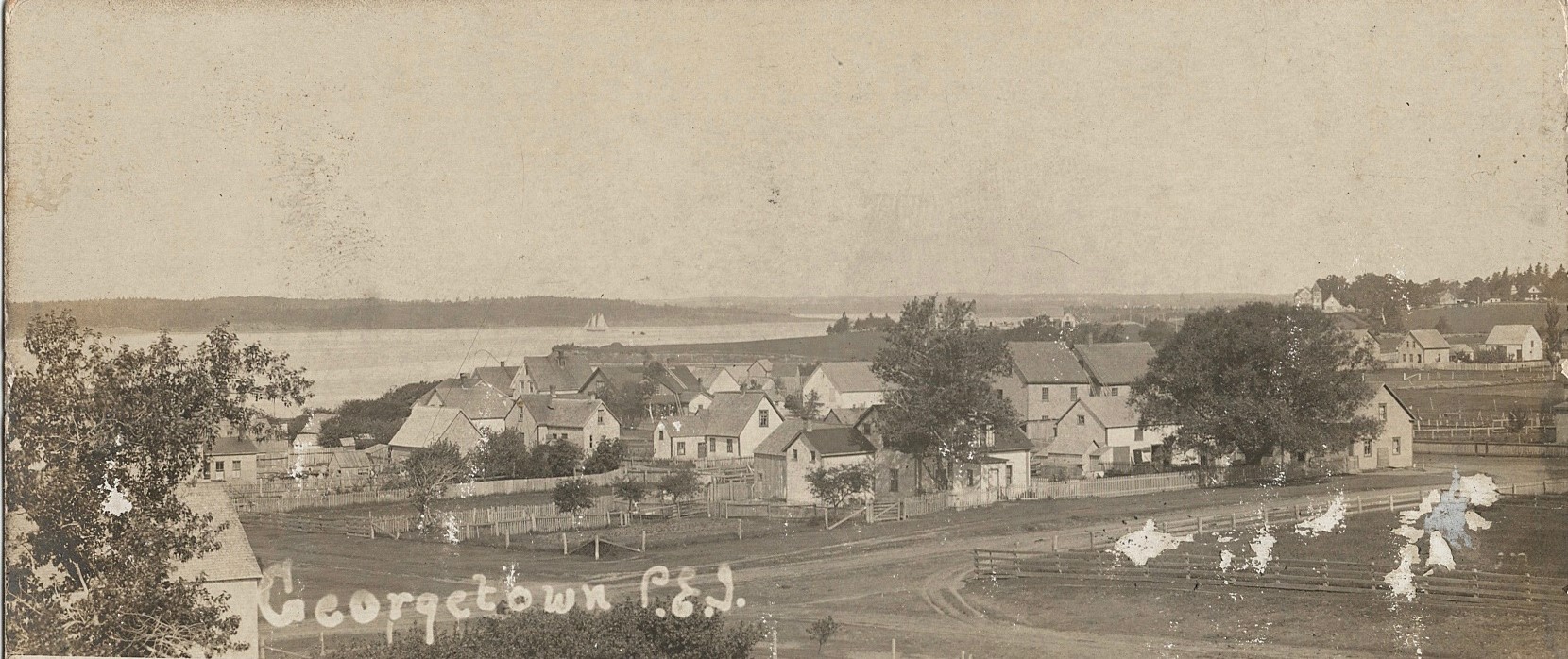
Government and Politics
The Municipality of Three Rivers is administered by a mayor and eight councillors who are elected for a four-year term and receive honorariums (see Municipal Government in Canada). The municipality’s administration operates out of buildings in Montague and Georgetown and employs approximately 16 people.
Cultural Life
Built in 1887, the King's Playhouse operated as a town hall and a locale for community and cultural events. One of Canada’s longest-running theatres, the playhouse burned during a storm in March of 1983, was rebuilt, and reopened in July of 1984. In addition to theatre and concerts, the playhouse has an art gallery and also operates as a wedding venue.
Located in Kent Square and named after Georgetown’s Father of Confederation, the A.A. MacDonald Memorial Gardens consist of 3.8 acres containing sixty flowerbeds with 15,000 annual plants and hundreds of perennials. The focal point of the gardens is a war cenotaph. (See also Andrew Archibald MacDonald.)

 Share on Facebook
Share on Facebook Share on X
Share on X Share by Email
Share by Email Share on Google Classroom
Share on Google Classroom

